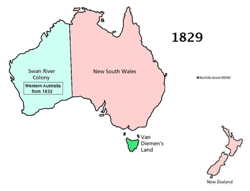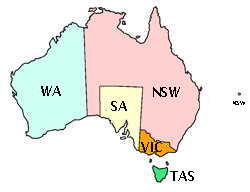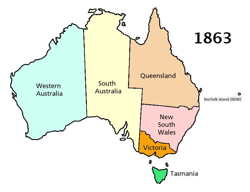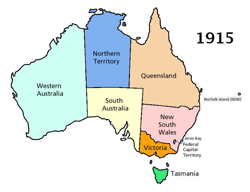Australia
When seeking information about ancestors, a knowledge of where they lived is paramount to locating records.
When researching regions before the start of civil registration this becomes even more significant as the records were generated at the local level. Knowing where the family lived will point you towards the appropriate repositories.
A surprising number of boundaries and borders have changed over the generations and the region the particular place is located in today could be entirely different. This may mean the records sought could be located in unexpected places and therefore a good understanding of borders and boundaries is important.
Apart from boundaries created by civil jurisdictions, a knowledge of the boundaries of ecclesiastical authorities is also significant. This is particularly so in the era prior to the introduction of civil registration when the Established Church maintained what we today would consider a civil function. Even in regions without an established church, such knowledge can be important. As an example, consider South Australia where civil registration started in a limited way in mid-1842. A Catholic priest from Sydney, William Ullathorne, visited Adelaide in June 1840 and conducted baptisms (about 26) when the colony was under the jurisdiction of a bishop based in Sydney. With no churches or resident priests in SA at the time, he took the register back to Sydney and
it was eventually deposited with the New South Wales BDM Registry.
Furthermore there are a significant number of examples where sections of the community were slow to accept civil registration and early legislation allowed these loopholes to persist. For example many Catholics refused to register the births of children until legislation established penalties for failing to do so.
When civil registration was introduced some remote areas were originally either not included or were too remote for the authorities. For example civil registration was introduced to South Australia in mid 1842 but the bulk of the land mass of the colony remained outside the boundaries of the registration districts for a decade or so. Even when the whole colony was covered some areas proved just too remote to be effectively covered.
In some cases, a failure to register an event can be resolved by reference to parish records.
|
Region
|
Code
|
Location
|
Establishment
|
 |
|
New South Wales
|
NSW
|
1788 All of Australian continent inc NZ, TAS and NKI except that area west of 133E. Western border extend to 129E 16 Jul 1825. Land area lost to other colonies progressively.
|
26 Jan 1788
|
|
Van Diemens Land
|
|
See TAS
|
3 Dec 1825
|
|
Swan River
|
|
An outpost of NSW established at present day Albany, then called King George Sound.
See Western Australia.
|
18 Jun 1829
|
|
Western Australia
|
WA
|
16 Jan 1825 border with NSW established. After the establishment of the Swan River Colony in 1829 control of King George Sound established 1826 was transferred from New South Wales. It was decreed that the settlement would be renamed Albany from 1832.
|
7 Feb 1832
|
 |
|
South Australia
|
SA
|
Western border 132E extended 22 Jul 1861 to present day position.
|
28 Dec 1836
|
|
New Zealand
|
NZ
|
Independent of NSW.
|
16 Nov 1840
|
|
Victoria
|
VIC
|
Independent of NSW.
|
1 Jul 1851
|
|
Tasmania
|
TAS
|
Formerly Van Diemens Land.
|
1 Jan 1856
|
|
Norfolk Island
|
NKI
|
Independent colony until 1 Jan 1901. Then an external territory of the Commonwealth. A self-governing territory 1979-2015. Since 2015 a local government disrtict within NSW.
|
8 Jun 1856
|
|
Queensland
|
QLD
|
Independent of NSW.
Western border 141E extended 13 Mar 1862 to present day position.
|
6 Jun 1859
|
 |
|
Northern Territory
|
NT
|
Under the control of SA until 1 Jan 1911 Divided into North Australia and Central Australia at 20S 1 Feb 1927 until 12 Jun 1931.
|
6 Jul 1863
|
|
Capital Territory
|
ACT
|
Established as the Federal Capital Territory until 29 Jul 1938. Jervis Bay added 12 Jul 1915 to 11 May 1989 and now separate.
|
1 Jan 1911
|
 |
|
Cocos (Keeling) Islands
|
CC
|
Annexed by Britain 1857; part of Straits Settlements 1867; attached to Ceylon 1942; Singapore 1946.
|
23 Nov 1955
|
| Christmas Island |
CX |
Annexed by Britain 1888; part of Straits Settlements 1867; attached to Ceylon 1942; Singapore 1946. |
1 Jan 1958 |
|
Jervis Bay
|
|
Split from ACT.
|
11 May 1989
|
The codes used for Australia are the accepted post office state codes prior to the introduction of postcodes.
Other Australian territories
Territory of Ashmore and Cartier Islands
The Territory of Ashmore and Cartier Islands are two groups of small low-lying uninhabited tropical islands in the Indian Ocean situated on the edge of the continental shelf north-west of Australia
The territory includes Ashmore Reef (West, Middle, and East Islets) and Cartier Island and there are no ports or harbours. Nearby Hibernia Reef, 42?km northeast of Ashmore Reef, is not part of the territory, but belongs to Western Australia.
The terrirory was handed to Australia by Britain in 1934 and attached to the Northern Territory unitl self-government was instituted in the Northern Territory in 1978.
Indonesian fisherman are permitted to land on West Island for fresh water, visit the graves and to take shelter in the West Island Lagoon.
Commonwealth laws, laws of the Northern Territory and Ordinances made by the Governor-General make up the body of law applicable
Australian Antarctic Territory
The Australian Antarctic Territory was claimed by the United Kingdom and placed under the authority of the Commonwealth of Australia in 1933. It is the largest territory of Antarctica claimed by any nation.
The Australian Antarctic Territory Act 1954 provides for Commonwealth laws expected to extend to the Territory, for Territory ordinances, for application of Australian Capital Territory laws (except criminal laws) and for application of Jervis Bay Territory criminal laws.
Most countries do not recognise territorial claims in Antarctica.
Coral Sea Islands Territory
The Coral Sea Islands Territory includes a group of small and mostly uninhabited tropical islands and reefs in the Coral Sea, northeast of Queensland, Australia. The only inhabited island is Willis Island.
The Coral Sea Islands were first charted in 1803; in the 1870 and 1880s the islands were mined for guano but the absence of a permanent supply of fresh water prevented long-term habitation. The territory was created in 1969 by the Coral Sea Islands Act and previously the area was considered part of Queensland. It was extended in 1997 to include Elizabeth and Middleton Reefs nearly 800 km to the south.
|
Overview of islets and cays
|
Type |
No of Islets/cays |
| West Holmes Reef |
atoll |
2 |
| Diane Bank |
atoll (mostly sunken) |
1 |
| Willis Group |
atoll (partially sunken) |
3 |
| Magdelaine Cays and Coringa Islets |
atoll (partially sunken) |
4 |
| Herald Cays (North) |
reef |
1 |
| Herald Cays (South) |
reef |
1 |
| Lihou Reef and Cays |
atoll |
18 |
| Diamond Islands and Tregosse Reefs |
atoll (partially sunken) |
4 |
| Flinders Reefs (North) |
atoll |
2 |
| Marion Reef |
atoll |
4 |
| Mellish Reef |
atoll |
1 |
| Frederick Reefs |
atoll |
1 |
| Kenn Reef |
atoll |
1 |
| Saumarez Reef |
atoll |
2 |
| Wreck Reef |
atoll |
3 |
| Cato Reef |
atoll |
1 |
| Middleton Reef |
atoll |
1 |
| Elizabeth Reef |
atoll |
1 |
The laws of the Australian Capital Territory (so far as they are applicable) apply in the Territory and the Supreme Court of Norfolk Island (which consists of Judges of the Federal Court) exercised criminal jurisdiction in the Territory until 2016.
Heard Island and McDonald Islands
The Heard Island and McDonald Islands are a volcanic group of barren Antarctic islands, about two-thirds of the way from Madagascar to Antarctica. Discovered in the mid-19th century, they have been territories of Australia since 1947 and contain the only two active volcanoes in Australian territory, one of which, Mawson Peak, is the highest Australian mountain.
The islands are among the most remote places on Earth and are currently uninhabited.
The Heard Island and McDonald Islands Act 1953 provides for Commonwealth laws expected to extend to the Territory, for Territory ordinances, for application of Australian Capital Territory laws (except criminal laws) and for application of Jervis Bay Territory criminal laws.
|